Navigation and Guidance

In order to achieve the highest possible throughput in material handling, automated guided vehicles (AGVs) must be reliably navigated in every situation. Pepperl+Fuchs offers the right sensors and technologies for these challenges—whether free navigation, floor-based navigation, or motion tracking.
While free navigation is based on the detection of spatial contours or reflectors attached to orientation points, floor-based navigation is based on guidance by color bands, codes, or RFID tags on the ground. Motion tracking provides data from motion sensors that can be used to estimate changes in position over time. For all these types of navigation, Pepperl+Fuchs offers a wide range of powerful technologies that ensure the highest precision in navigation and guidance.
Solutions for Free Navigation
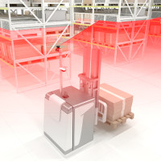
Automated guided vehicles (AGVs) are increasingly taking over the transport of goods in warehouse and production logistics. In doing so, they are to be navigated from point to point with high accuracy. The R2000 series LiDAR sensors with Pulse Ranging Technology (PRT) used for these tasks are the world's leading solution for precise navigation and offer a 360° all-round view with the greatest angular resolution in their class. They therefore deliver highly accurate measurement results for determining the absolute position.
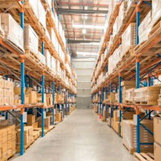
In logistics centers, each package is taken individually from the rack and loaded into a cart. The loaded cart is then pushed or pulled to the unloading station by an employee, which is time-consuming and requires a lot of strength. Automated guided vehicles are used here to follow the warehouse worker, increasing efficiency and convenience. The R2000 series 2-D LiDAR sensor measures the trolley's surroundings at a 360° angle and detects the direction of travel to reliably follow the employee.
Solutions for Floor-Based Navigation

In automated production lines, the positioning of AGVs must meet the requirements of functional safety. The safePGV positioning system enables safe absolute positioning according to SIL 3/ PL e with only one sensor. Rugged metal code bars are available for sections of the line subject to heavy mechanical stress.
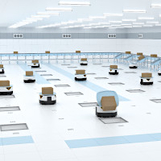
When transporting shipping containers by small AGVs, high throughput is crucial. This can only be achieved if the routes of the bots are coordinated as perfectly as possible and monitored in real time. The Position Guided Vision (PGV) positioning system captures the position data of the bots, enabling transport journeys at high speed. For this purpose, the read device mounted on the underside of the bot detects Data Matrix tags on the ground and transmits the position data obtained from them to the controller.
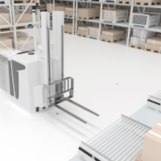
LiDAR sensors are used in lane-guided automated guided vehicles (AGVs) to monitor a safety field in the direction of travel. In order for this field to be adapted to the situation at defined points, such as gateways, the position of the vehicle must be reliably determined. In this context, RFID tags embedded in the ground at specific points provide precise absolute position data that serve as reference points. They are reliably recorded by a compact RFID read/write device of the type IQT1-FP-R4-V1 mounted on the AGV.
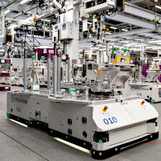
The automated guided system of Staudinger GmbH Automatisierungstechnik is successfully used in the axle assembly of a well-known Bavarian automobile manufacturer. Here, the powerful PGV positioning system ensures reliable track guidance. In safety-relevant areas, the safePGV positioning system and inductive safety sensors with SIL 2/PL d certification from Pepperl+Fuchs are also used.
Solutions for Motion Tracking
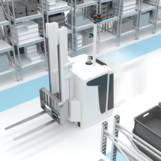
Inductive safety sensors of the NSB and NSN series are used to reliably navigate AGVs even in cold storage rooms with very low temperatures or in outdoor areas with harsh weather conditions. They meet PL d and SIL 2 functional safety requirements and provide precise data for direction detection. Variants with extended temperature range and high degrees of protection enable use in harsh environments.
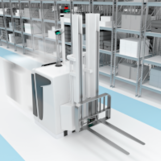
In the navigation of automated vehicles, optical sensors take over the task of orientation in space. To precisely determine their own position, AGVs need additional data while driving. For this task, two measuring systems are combined: an incremental rotary encoder and a 2-D LiDAR sensor. Incremental rotary encoders of the ENI58IL, TVI40, or MNI series are mounted on the wheels and provide relative motion information that is offset against the absolute position information from the 2-D LiDAR sensor to produce a precise position determination.

To accurately determine the position of AGVs at all times, even during cornering and evasive maneuvers, the F99 inertial measurement system is used in addition to optical sensors. It provides inclination, acceleration, and rotation rate values for dynamic position determination. It enables precise navigation of AGVs and smooth positioning processes between the various stations and processing locations in material handling.







 +1 330 425-3555
+1 330 425-3555